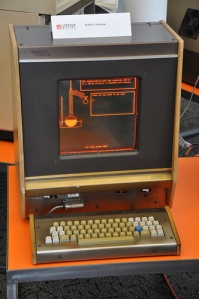Professors of media – both new and traditional – sometimes do not agree on the finer points of whether all this new interactive media is indeed, finer than what it seeks to replace.
Recently, CUNY Journalism Prof. Jeff Jarvis got into a friendly discussion with ePresse consortium general manager Frédéric Filloux regarding the role of social media tools in the news gathering and storytelling functions. Their discussion reminds me of scenarios that played out numerous times in my journalism carrer whenever I interviewed for a new reporting position at a different publication.
Jarvis – who has been leading the Web 2.0 revolution in journalism since before Web 2.0 had a name – stated in his blog, BuzzMachine, that:
“A few episodes in news make me think of the article not as the goal of journalism but as a value-added luxury or as a byproduct of the process.”
After stating several notable examples where news events have been tweeted and blogged in real time, Jarvis goes on to say:
“Carry this to the extreme — that’s my specialty — and we see witnesses everywhere, some of them reporters, some people who happen to be at a news event before reporters arrive (and now we can reach them via Twitter, Facebook, Foursquare….), some who may be participants but are sharing photos and facts via Twitter. Already on the web, we see others — bloggers — turn these distributed snippets into narratives: posts, stories, articles.
The bigger question all this raises is when and whether we need articles. Oh, we still do. Articles can make it easy to catch up on a complex story; they make for easier reading than a string of disjointed facts; they pull together strands of a story and add perspective. Articles are wonderful. But they are no longer necessary for every event. They were a necessary form for newspapers and news shows but not the free flow, the never-starting, never-ending stream of digital. Sometimes, a quick update is sufficient; other times a collection of videos can do the trick. Other times, articles are good.”
Filloux, who co-writes the Monday Note ‘blog, took issue with Jarvis:
“Defining article as a “luxury or a byproduct” as Jeff Jarvis did last month, is like suggesting jazz is secondary to rap music, or saying literature is a Deluxe version of slamming. Reading Jarvis’ Buzz Machine blog is always interesting, often entertaining and more than occasionally grating. His May 28th blog post titled The article as luxury or byproduct reverberated across the media sphere – as provocative pieces are meant to, regardless of the argument’s actual connection with facts.”
Filloux says that he teaches his students that live blogging and tweeting is not journalism but a tool, “sometimes an incredibly efficient one…”
“The article actually is the essence of journalism. And by no means a “byproduct of the process”.
Two and a half years ago, the Airbus landing in the Hudson became the poster-child for crowd-powered breaking news. Then, the only true visual document was a cell phone picture taken by a ferry passenger. Today, the same event would have been live-tweeted by a dozen of witnesses using all the digital nomad firepower you can think of, from hi-res pics to HD video. And, by the time the genuine reporters show up, all relevant material would have been broadcast to the entire world.
Then, if we follow the Jarvis Doctrine, any additional reporting – let alone narrative reconstruction – would become extraneous or useless. (OK, I’m slightly over the top here).
Still, this “extraneous or useless” byproduct is precisely when and where the real craft enters the media stage. For me, William Langewiesche’s 11,000 words article in Vanity Fair became one of the most compelling stories ever written about this spectacular event.”
Jarvis counters with an article-length post answering Filloux:
“Frédéric Filoux willfully misrepresents me so that he may uphold the orthodoxy of the article. He will be disappointed to learn that we agree more than he wishes. Here is what I am really saying about the article.
First, far from denigrating the article, I want to elevate it. When I say the article is a luxury, I argue that using ever-more-precious resources to create an article should be taken seriously and before writing and editing a story we must assure that it will add value. Do most articles do that today? No. Go through your paper in the morning and tell me how much real value is added and how much ink is spilled to tell you what you already know (whether that is facts you learned through Twitter, the web, TV, radio, et al or background that is reheated more often than a stale slice in a bad New York pizzeria).”
I met Jarvis in 2004 at a conference during which he was live-blogging a panel discussion he was simultaneously hosting. His blog posts were projected above his head while he talking about blogging. It was weird and disarming. Now that level of split attention is normal.
It struck me, as I said, that I’ve had this conversation before.
Journalism interviews are grueling, day-long affairs where you meet dozens of people and they all get to weigh in on whether you get the job. At some point, some editor asks you this question:
“Are you more of a reporter or a writer?”
At first the two might seem synonymous, but the editor is getting at the heart of how you see yourself and what your greatest value to the organization is going to be. Reporters are experts at research and social engineering. They know how to develop sources and tap them for the most valuable information when it counts. Reporters navigate professional and personal relationships to find the best information that helps make a story make sense to the reader.
Writers, on the other hand, really know how to turn a phrase. They produce stories that are informative, entertaining, concise and truthful. Writers cut through to the essence of a story and tell readers what is most important to know and why it is important to know it.
This is the same tension playing out between Jarvis and Filloux. Reporting is a process. Writing is the storytelling.
The difference now is that by using social media tools, the readers and viewers can witness the process. In addition, we can now all witness news events being “reported” by people who traditionally would not be considered reporters. At best, they would have been sources for a reporter. Now, they can be the primary source of the information.
I’m tempted to say that both Jarvis and Filloux are right. Just as you cannot have a good journalistic story without solid reporting, journalism will now forever have to deal with the news gathering process being not only visible to the audience, but also open for audience participation in the process.
I have a feeling that from now on, journalism will have to account for Heizenberg’s uncertainty principle — that the more precisely you attempt to measure something, the less precisely its future position can be determined.










 Finally getting the hang of the new template that replaced my 12-year-old one, I have updated
Finally getting the hang of the new template that replaced my 12-year-old one, I have updated